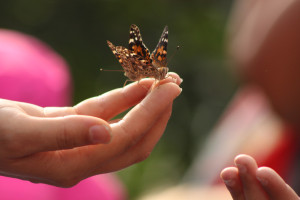alou Phelps Natural Area is a four-acre grassy hill in San Francisco’s Bayview neighborhood, rising out of a children’s playground and mini-park into a toyon-and-wildflower dotted crest with a panoramic city view.
Houses flank the natural area, rising along with the hill, and one of those property owners would like to build two additional houses — three stories, roughly 5,000-square feet each — in what are now two undeveloped private back lots bordering the open space area. This is where it gets complicated: there’s no road to those lots. So a developer building houses also has to build a new road across city-owned public land.
What they intend to do, according to the most recent version of plans submitted to the city Planning Department, is take the street that dead ends at the right edge of this picture, Quesada Avenue, and drag it about 300 feet up this hillside owned by the Department of Public Works. Which would mean DPW would have to approve a permit for an easement, or, more succinctly, that DPW would get a chance to decide the fate of the hill.

ou would expect, standing at the base of the hill on a foggy summer morning, looking up at an unremarkable slope crowned with box houses, littered with broken glass and tangled with senescent invasive grasses, that the city would shrug and grant the permit. But it’s a much more difficult decision, the group Nature in the City believes, if you know that up there is also a thriving ecological community, a rare example of remnant San Francisco prairie with more than 35 native plants — including California saxifrage that only grows in one other place in the city — birds, bugs, lichens, and butterflies.
So earlier this week Nature in the City adopted the citizen science “bioblitz” and turned it to support the preservation of Palou Phelps. A dozen or so volunteers, a handful of experts, and about 30 school-age children from the Bayview YMCA spent two hours combing the hillside for as much biodiversity as they could find. (Not too much. Mostly plants.)
“It’s really important you’re out here today, because we’re trying to save this place,” Nature in the City Executive Director Amber Hasselbring said just before letting the kids run off. “This is a bioblitz with a mission.”
The road as proposed wouldn’t wipe out the natural area, but it would take up about one half of an already small open space, and roads bring with them an impact halo that goes well beyond their actual footprint. In the roughly three-square-mile triangle bound by Third Street, Highway 101, and Interstate 280, Palou Phelps is the only open space area.
s the fog cleared Tuesday morning, Peter Brastow, a biodiversity coordinator with San Francisco’s Department of the Environment, hiked a group of YMCA kids up the scrambly dirt trail, and asked them what they saw. “A freeway!” someone said.
“How many freeways?” Brastow asked.
“Two!”
He pointed out 101, the roadway itself barely visible under the mess of cars. He pointed to 280, a double-deckered cement millipede carving through the neighborhood as it marches downtown.
“What’s special about this hill is it’s what San Francisco used to look like,” Brastow said. “Before freeways.”
He parked the group right above where the future road would be built. Brastow pointed to scattered clumps of seaside buckwheat and California poppy. He pulled up invasive radish and red runners of sheep sorrel. The kids asked good questions: How do you tell the difference between male and female flowers? Is anything here poisonous? What’s that butterfly? Was that a snake?

n a little under two hours of bioblitzing, 10 iPhone-wielding observers logged 43 different species in iNaturalist. None of those species are endangered. Most of them, even the natives, are common — California poppies, yarrow, Ithuriel’s spear, cabbage white and gray hairstreak butterflies.
The Planning Department is waiting for a final proposal from the developer before finishing its environmental review, said city planner Brett Bollinger. Then it’ll evaluate the project based on the California Environmental Quality Act, which seems perhaps unlikely to pose serious objections because there’s a pleasant patch of common yarrow in the bulldozer’s path. Rachel Gordon, a DPW spokeswoman, said nothing’s been delivered to Public Works yet, so the agency is still waiting to see the newest plan.
The broader point, Nature in the City Public Advocacy Coordinator Zahra Kelly said, is there has to be a better way to calculate the value of preserving an open space. There’s increased property value for neighbors who like the open space. There’s the value of preserving San Francisco’s native seed bank. There’s the value of plants holding down erosion. There’s the value of not adding to the urban heat island effect. The street might be there on paper, but that shouldn’t make its construction inevitable, she said. “The value of this paper street is more than potential access road for private single family homes,” Kelly wrote in an email. “The BioBlitz results indicate that Palou Phelps Natural Area is not just an open space ready for development. This place is alive, and it provides habitat, and it is a valuable ecosystem in our city which provides many benefits to us. We just have not figured out how to calculate its many benefits in monetary terms yet.”




-300x225.jpg)
-300x221.jpg)